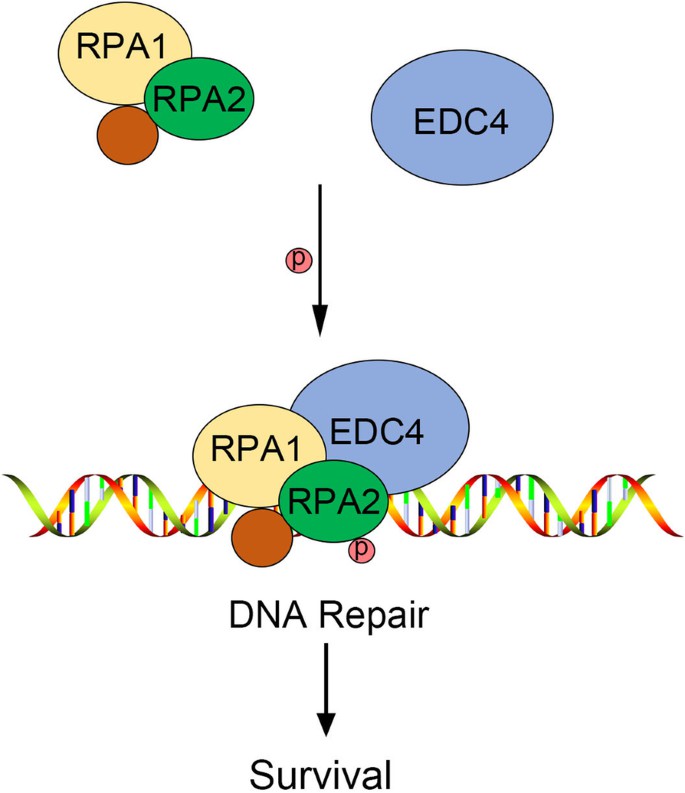What is RPA2 Protein
The Replication Protein A2 (RPA2) is a protein encoded by the RPA2 gene in humans. This protein is one of the three subunits comprising Replication Protein A (RPA), the others being RPA1 and RPA3. The RPA is a single-stranded DNA-binding protein involved in DNA replication, repair, and recombination. The RPA plays a critical role in protecting single-stranded DNA from degradation and forming a nucleoprotein complex to facilitate various DNA metabolic processes.
The discovery of RPA2 dates back to the 1980s when scientists began intense research on DNA replication and repair mechanisms in eukaryotic cells. The RPA was found to have a central role in these processes, and subsequently, individual subunits, including RPA2, were later identified and studied in more detail in the 1990s.
The RPA2 gene is located on human chromosome 1 at locus 1p35-1p36, a region rich in genes essential for the DNA repair process. The protein encoded by this gene contains approximately 270 amino acids and has a known molecular weight of around 32 kDa.
The structure of the RPA2 protein provides a fundamental understanding of its function. RPA2, much like the other RPA subunits, has a unique and complex structure vital for its diverse functions in the cell. It consists of an N-terminal domain for protein interaction and C-terminal domain involved in the cell cycle regulation via phosphorylation.
Function of RPA2 protein
RPA2 is critical in DNA replication processes due to its ability to bind and stabilize single-stranded DNA, preventing it from forming secondary structures that could hinder replication. It acts in synchronization with other elements of the replication machinery to guarantee the accuracy and efficiency of DNA replication.
RPA2 also plays a significant role in DNA repair. During repair, RPA2 stabilizes single-stranded DNA generated at the site of damage, enabling efficient repair machinery recruitment. The protein also has roles in recombination and activation of checkpoint signaling following DNA damage.

(Wu, X., et al. 2020)
RPA2 protein related signal pathway
The primary signaling pathway associated with RPA2 is DNA damage response, particularly during replication stress. RPA2 is frequently phosphorylated in response to a variety of DNA-damaging agents. This phosphorylation is a key event in replication stress signaling, as it recruits Rad9-Hus1-Rad1 (9-1-1) checkpoint clamp to the damage site, signaling downstream effectors and eventually leading to cell cycle arrest to allow DNA repair.
RPA2 Protein Related Diseases
Mutations and alterations in RPA2 and associated pathways correlate with several diseases, particularly cancer. For instance, increased expression of RPA2 is often found in lung, breast and gastric cancers, indicating its potential as a diagnostic biomarker. Moreover, RPA2's role in DNA repair and replication suggests that alterations in its function could lead to genomic instability – a common feature of malignant cells.
Biomedical Applications of RPA2 Protein
Given its critical roles in DNA replication and repair, RPA2 has become a compelling target for therapeutic intervention, particularly in cancer. Inhibitors targeting RPA2 functions can potentially render cancer cells more susceptible to chemotherapy by disrupting their ability to repair DNA damage.
Moreover, RPA2 and its phosphorylation status could serve as potential biomarkers for replication stress or DNA damage in cells. Recent advances in proteomics and related fields allow for monitoring of RPA2 levels and modifications, extending its potential applications in diagnostics, prognostics, and monitoring the efficacy of anticancer therapies.
In conclusion, the RPA2 protein, as an integral part of the DNA replication and repair machinery, represents an exciting area of research with significance in comprehending the fundamental biological processes and potential applications in disease diagnosis and treatments. Further research into this lesser-known protein could unravel new opportunities for biomedical advancements.
Our Featured Products
| Cat.No. | Product Name | Species | Source (Host) | Tag |
|---|---|---|---|---|
| RPA2-3440H | Recombinant Human RPA2 protein, GST-tagged | Human | E.coli | GST |
| RPA2-1430HFL | Recombinant Full Length Human RPA2 Protein, C-Flag-tagged | Human | Mammalian cells | Flag |
| RPA2-3892H | Recombinant Human RPA2 protein, His-tagged | Human | E.coli | His |
| RPA2-1910H | Recombinant Human RPA2 Protein, His (Fc)-Avi-tagged | Human | HEK293 | His (Fc)-Avi |
| Rpa2-5579M | Recombinant Mouse Rpa2 Protein, Myc/DDK-tagged | Mouse | HEK293T | Myc/DDK |
| RPA2-4758R | Recombinant Rat RPA2 Protein, His (Fc)-Avi-tagged | Rat | HEK293 | His (Fc)-Avi |
| RPA2-3776R | Recombinant Rhesus Macaque RPA2 Protein, His (Fc)-Avi-tagged | Rhesus Macaque | HEK293 | His (Fc)-Avi |
Reference
- Wu, X., Zhong, Y., Chen, Q. et al. Enhancer of mRNA Decapping protein 4 (EDC4) interacts with replication protein a (RPA) and contributes to Cisplatin resistance in cervical Cancer by alleviating DNA damage. Hereditas 157, 41 (2020). https://doi.org/10.1186/s41065-020-00154-w

